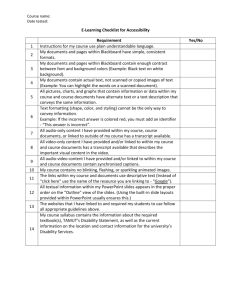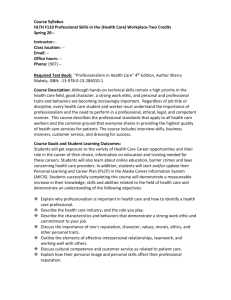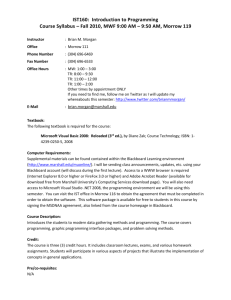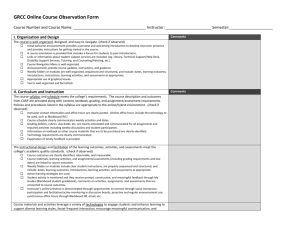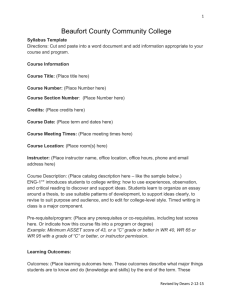Behavior Management for Exceptional Learners
advertisement
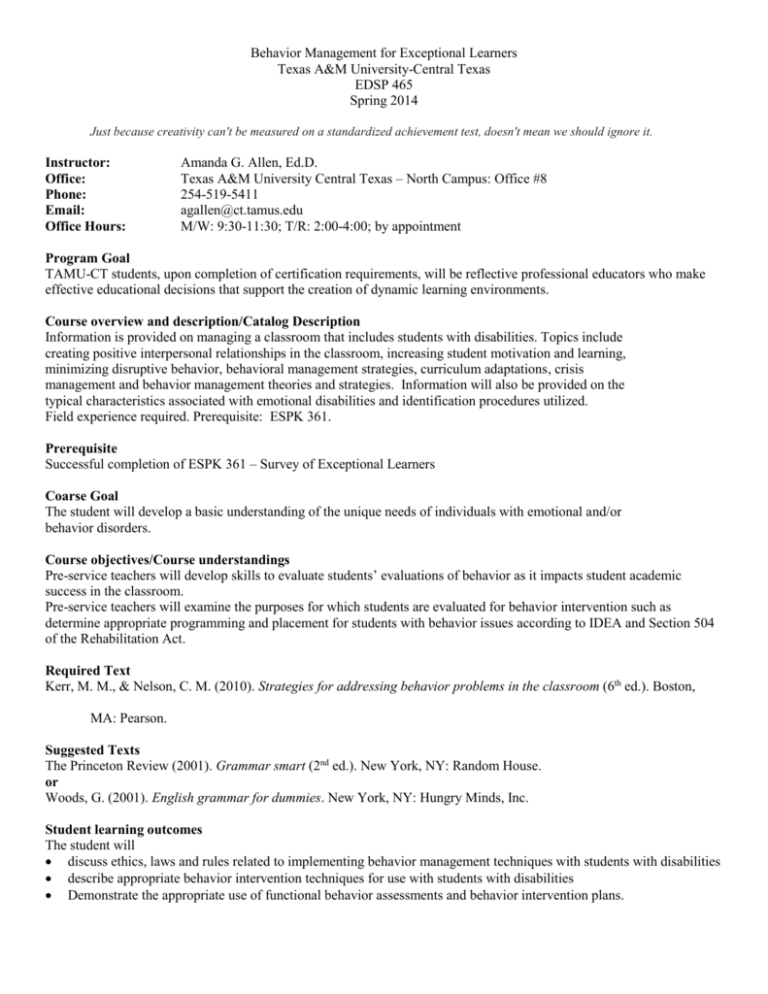
Behavior Management for Exceptional Learners Texas A&M University-Central Texas EDSP 465 Spring 2014 Just because creativity can't be measured on a standardized achievement test, doesn't mean we should ignore it. Instructor: Office: Phone: Email: Office Hours: Amanda G. Allen, Ed.D. Texas A&M University Central Texas – North Campus: Office #8 254-519-5411 agallen@ct.tamus.edu M/W: 9:30-11:30; T/R: 2:00-4:00; by appointment Program Goal TAMU-CT students, upon completion of certification requirements, will be reflective professional educators who make effective educational decisions that support the creation of dynamic learning environments. Course overview and description/Catalog Description Information is provided on managing a classroom that includes students with disabilities. Topics include creating positive interpersonal relationships in the classroom, increasing student motivation and learning, minimizing disruptive behavior, behavioral management strategies, curriculum adaptations, crisis management and behavior management theories and strategies. Information will also be provided on the typical characteristics associated with emotional disabilities and identification procedures utilized. Field experience required. Prerequisite: ESPK 361. Prerequisite Successful completion of ESPK 361 – Survey of Exceptional Learners Coarse Goal The student will develop a basic understanding of the unique needs of individuals with emotional and/or behavior disorders. Course objectives/Course understandings Pre-service teachers will develop skills to evaluate students’ evaluations of behavior as it impacts student academic success in the classroom. Pre-service teachers will examine the purposes for which students are evaluated for behavior intervention such as determine appropriate programming and placement for students with behavior issues according to IDEA and Section 504 of the Rehabilitation Act. Required Text Kerr, M. M., & Nelson, C. M. (2010). Strategies for addressing behavior problems in the classroom (6th ed.). Boston, MA: Pearson. Suggested Texts The Princeton Review (2001). Grammar smart (2nd ed.). New York, NY: Random House. or Woods, G. (2001). English grammar for dummies. New York, NY: Hungry Minds, Inc. Student learning outcomes The student will discuss ethics, laws and rules related to implementing behavior management techniques with students with disabilities describe appropriate behavior intervention techniques for use with students with disabilities Demonstrate the appropriate use of functional behavior assessments and behavior intervention plans. Assessment components Presentation: Disabilities/Conditions (10) Research and present a disability or condition related to an emotional disturbance or one that is linked with mental health. Create a multimedia presentation. Your presentation will not exceed 20 minutes in length but will be no less than 10 minutes. The instructor will provide you with a rubric with specific requirements. Presentation: Models of Disturbance (20) Present with peers a model of disturbance. Using information from texts, journal articles, resource books, websites, and other sources, research, discuss, and teach the class about one of the following models of disturbance: psychodynamic, cognitive, ecological, biophysical, or behavioral. Include in your presentation basic assumptions of the model and its implications for assessment, treatment, and educational programming for students with EBD. Provide a handout for each student outlining the elements of your presentation including at least five (5) references other than our text. To aid your presentation, develop a visual component. The presentation will not exceed 30 minutes in length but will be no less than 15 minutes. The instructor will provide you with a rubric with specific requirements. Article Reviews (2 @10 pts. ea.) Read and review two articles that reflect practices in the field of Emotional Disorders. Topics may include but are not limited to assessment, instruction, behavior management, collaboration, or specific intervention procedures. Articles must refer specifically to students/people with emotional or related disorders. Use any appropriate peer-reviewed journal for these reviews. The review should be three (3), no more than four (4) pages, double-spaced, and include the following information: a summary of the article, a one to two-paragraph reaction and comments regarding the content, and a correct APA citation of the article. Place your name and article information (correct APA citation) at the bottom of the final page and not prior to this. Provide with your review a copy of the article even if I provide the article. You need no cover page. Be prepared to present your article’s content briefly but completely to the class. If someone else presents the same article previously, be prepared to bestow a morsel of wisdom upon your audience. Field Experience and Reflective Journal (20 pts) Complete a 20-hour field experience during the semester interacting with students with disabilities over a five to seven week period of time. Turn in the following information for your field experience: Permission sheet from principal and teacher signed time sheet for each visit reflective journal of your time in your field experience placement required assignments throughout your field experience Exams (2 @ 10 pts ea.) Complete a midterm and a final exam covering topics discussed in class and within required reading material. Professionalism (10 pts.) Evaluation summary: Disabilities/Conditions ED Model Presentations Article reviews Field Experience Midterm Exam Final Exam Professionalism Total Points 10 20 20 20 10 10 10 100 A = 100 - 90 B = 89 - 80 C = 79 - 70 D = 69 - 60 F = 59 > Professional behaviors: Professionalism, within the context of this course includes but is not limited to the following behaviors: TURN OFF CELL PHONES PRIOR TO THE BEGINNING OF CLASS. Using cell phones in any way, calling, receiving calls, sending and receiving texts, looking up information, etc. are disruptions and are disrespectful to your classmates and to your instructor. If the above instances occur, you risk losing professionalism points and being dismissed from class. If you decide these behaviors are important to you during class, do not be surprised that your final grade is one letter below what you expected due to the loss of all of your professionalism points. Put your laptop/notebook computers away during class discussion and whole group activities. I will inform you if you will need them. Assignments are to be submitted in a neat, orderly and professional format, using formal language, complete sentences, correct grammar and spelling; all assignments will be typed in 12 point Times New Roman, doublespaced on the front side only unless otherwise instructed. Participation includes both coming to class, being prepared for class, and being an active, contributing class member. Participation is part of your grade. Any act of academic dishonesty in this class may result in failure of the class and will result in a zero (0) on the assignment and a loss of professionalism points. Attendance constitutes being present in class during the entire class session. See Class Policies; Attendance. Timely submission of work; meeting course deadlines and due dates; Ten percent of the grade will be deducted for each day an assignment is turned in late. Supplemental assignments are not available. Students are responsible for obtaining notes, handouts, graded assignments, changes in schedules, and all other information if they are absent or tardy. The instructor is not responsible for assignments that are not picked up on the day they are returned Candidates for teacher certification at Texas A&M University - Central Texas will demonstrate the following qualities and behaviors in pursuit of their goal of becoming a professional educator: Communication – Communicate appropriately and effectively with colleagues, supervisors, parents, and members of the community. Use good oral and written communication skills. Collaboration – Work collaboratively with colleagues, mentors, and supervisors to achieve the local, state, and national goals of education. Show courtesy to peers, public school students, cooperating teachers and professors. Commitment – Demonstrate commitment to the teaching profession and exercise leadership for the advancement of the profession and public education. Show enthusiasm for learning in and out of class. Be responsible, punctual, regular in attendance and prepared to participate in all aspects of professional development. Professional Conduct – Assume responsibility for utilizing professional teaching practices and constantly strive to improve through professional growth. Observe confidentiality. Accept constructive feedback and demonstrate a willingness to make improvements in attitude and performance if needed. Ethical Conduct – Uphold the code of Ethics for Educators and abide by local, state, and federal rules, regulations, and policies. Demonstrate respect and maintain ethical conduct in relations with community. Exhibit honesty and personal integrity. Violations of ethics code, including plagiarism will result in a failing grade. The instructor reserves the right to modify the course outline if necessary. The students will receive as much advance notice as possible. Class Policies Academic Integrity Statement Any act of academic dishonesty in this class may result in failure of the class and will result in a zero (0) on the assignment and a loss of all professionalism points. In-class behavior: Please be considerate of your classmates, the instructor, and guest lecturers. This includes arriving on time for class and staying for the entire period. Listen carefully when someone else is speaking, do not engage in side conversations during lectures and discussions, stay on-task during small group activities, and respect each person’s opinions even if you do not agree with those opinions. Let us all try to treat each other with the respect and dignity that we would like to be accorded. “People First” language: People with disabilities are just that, people who have physical, sensory, behavioral, or intellectual disabilities. Avoid phrases both in speech and in writing such as “ special needs children,” “ADHD kids,” “the autistic,” or other statements that highlight the disability rather than the individual. Instead, speak and write in the way that puts the “person first,” for example, the student with a severe disability, the program for students with emotional disorders. This small change emphasizes the humanity and individuality of the person and clarifies that disability is only one of the many characteristics that people may possess. Attendance Professional behavior and commitment to teaching are my expectations of you and should be expectations you have of yourself . You may not make up work missed during the class period because it involves the interactions of students, professor, and content. More than two (2) class absences due to any circumstance may result in lowering the final points by one (1) letter grade. More than three (3) absences due to any circumstance may result in failure of the class. Two tardy arrivals of 30 minutes or more will equal one absence. The same consequences apply for being absent at any time during class. Students are responsible for obtaining notes, handouts, graded assignments, changes in schedules, and all other information when absent or tardy. The instructor is not responsible for assignments that are not picked up on the day they are returned. Being prepared to participate includes completing assigned readings and bringing necessary textbooks, assignments, and materials to class. Being prepared also includes having all handouts for the instructor and students prepared on the day and at the time the handouts are required. Late assignment policy: Ten percent will be deducted for each day an assignment is turned in late. If the assignment is due on Blackboard, and is late, the assignment date will not be reopened, therefore it will not be accepted. Supplemental assignments are not available. University Policies Academic Integrity Statement Texas A&M University - Central Texas expects all students to maintain high standards of personal and scholarly conduct. Students found responsible of academic dishonesty are subject to disciplinary action. Academic dishonesty includes, but is not limited to, cheating on an examination or other academic work, plagiarism, collusion, and the abuse of resource materials. The faculty member is responsible for initiating action for each case of academic dishonesty and report the incident to the Associate Director of Student Conduct. More information can be found at http://www.tamuct.edu/departments/studentconduct/facultyresources.php. Disability Support and Access If you have or believe you have a disability and wish to self-identify, you can do so by providing documentation to the Disability Support Coordinator. Students are encouraged to seek information about accommodations to help assure success in their courses. Please contact Vanessa Snyder at (254) 501-5836 or visit Founder's Hall 114. Additional information can be found at http://www.tamuct.edu/departments/disabilitysupport/index.php. Drop policy: If you discover that you need to drop this class, you must go to the Records Office and complete the necessary paperwork. Professors cannot drop students; this is always the responsibility of the student. The record’s office will provide a deadline for which the form must be returned, completed, and signed. Return the signed form to the records office, wait 24 hours, go into Duck Trax and confirm that you are no longer enrolled. If you are still enrolled, FOLLOW-UP with the records office immediately. Attend class until the procedure is complete to avoid penalty for absence. Should you miss the deadline or fail to follow the procedure, you will receive an F in the course. Library support: INFORMATION LITERACY focuses on research skills which prepare individuals to live and work in an informationcentered society. Librarians will work with students in the development of critical reasoning, ethical use of information, and the appropriate use of secondary research techniques. Help may include, yet is not limited to: exploration of information resources such as library collections and services, identification of subject databases and scholarly journals, and execution of effective search strategies.. Library Resources are outlined and accessed at http://www.tarleton.edu/centraltexas/departments/library/ Technological/Computer/Blackboard Use: This course will use the new TAMU-CT Blackboard Learn learning management system for class communications, content distribution, and assessments. Logon to https://tamuct.blackboard.com to access the course. 1. Username: Your MyCT username (xx123 or everything before the “@” in your MyCT e-mail address) 2. Initial password: Blackboard supports the most common operating systems: PC: Windows 8, Windows 7, Windows Vista Mac: Mac OS X Mavericks NOTE: Computers using Windows XP, Windows 8RT, and OS X 10.6 or lower are NO longer supported. Check browser and computer compatibility by following the “Browser Check” link on the TAMU-CT Blackboard logon page. (https://tamuct.blackboard.com) This is a CRITICAL step as these settings are important for when you take an exam or submit an assignment. Upon logging onto Blackboard Learn, you will see a link to Blackboard Student Orientation under My Courses tab. Click on that link and study the materials in this orientation course. The new Blackboard is a brand new interface and you will hae to come up to speed with it quickly. This orientation course will help you get there. There is also a link to Blackboard Help from inside the course on the left-hand menu bar. Technology issues are not an excuse for missing a course requirement – make sure your computer is configured correctly and address issues well in advance of deadlines. For technological or computer issues, students should contact Help Desk Central 24 hours a day, seven days a week: Email: helpdesk@tamu.edu Phone: (254) 519-5466 Web Chat: http://hdc.tamu.edu When calling for support please let your support technician know you are a TAMUCT student. For issues related to course content and requirements, contact your instructor. Tutoring Tutoring is available to all TAMUCT students, both on-campus and online. Subjects tutored include Accounting, Finance, Statistics, Mathematics, and Writing (APA). Tutors are available at the Tutoring Center in Founder's Hall, Room 204, and also in the Library in the North Building. Visit www.ct.tamus.edu/AcademicSupport and click "Tutoring Support" for tutor schedules and contact info. If you have questions or if you're interested in becoming a tutor, contact Academic Support Programs at 254-519-5830 or by emailing gnichols@ct.tamus.edu. UNILERT Emergency Warning System for Texas A&M University Central Texas UNILERT is an emergency notification service that gives Texas A&M University Central Texas the ability to communicate health and safety emergency information quickly via email and text message. By enrolling in UNILERT, university officials can quickly pass on safety-related information, regardless of your location. Please enroll today at TAMUCT.org/UNILERT WARRIORLink Online job database that connects employers with students with postings of internships, part-time, full-time jobs. All students will receive an email with their username and password the first week of school with access information. Warrior Link allows our students up until a year after they graduate the opportunity to search for a job, post a resume, and keep informed on any events that are going on out of the careers services area. The link to Warrior Link is located at www.tamuct.org/careerservices
